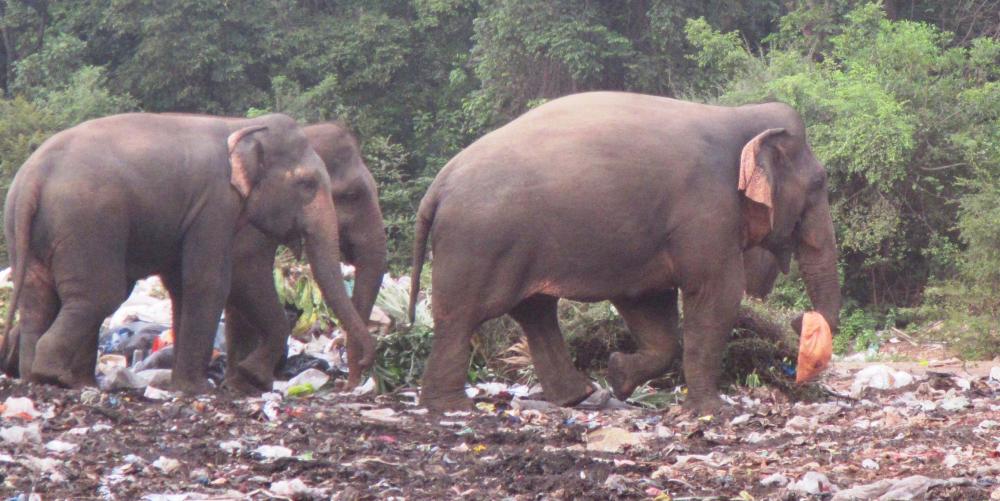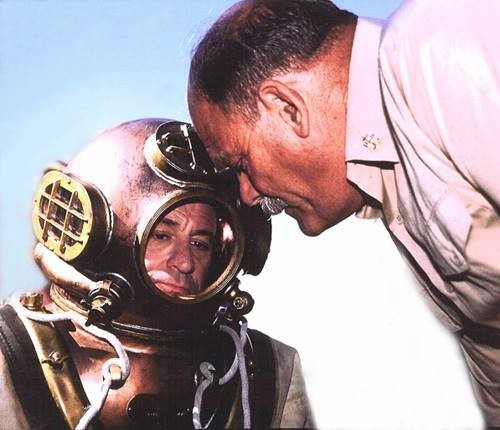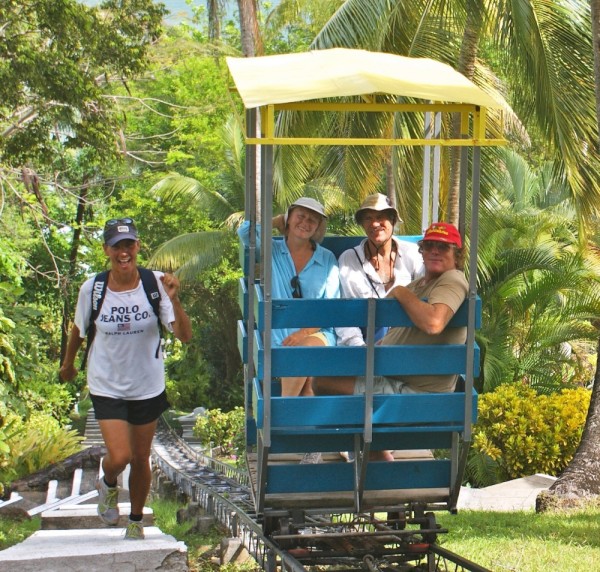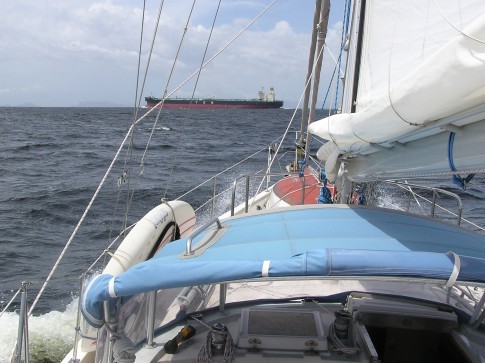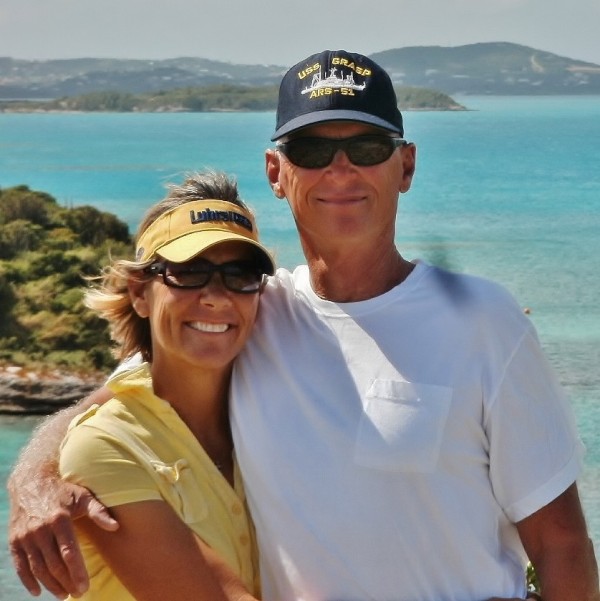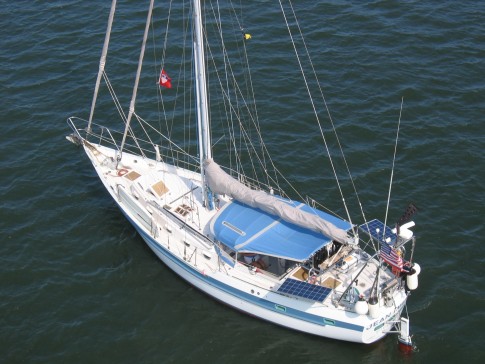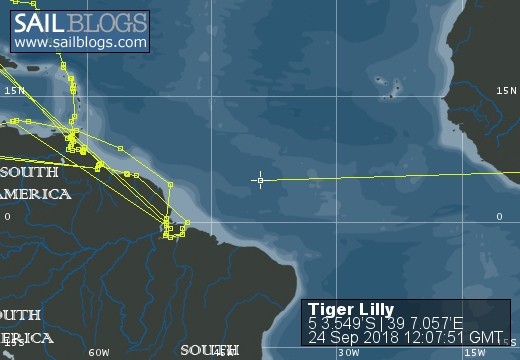
S/V Tiger Lilly
Rig heavy, reef early, and pray often; for God does not assure us an easy passage, but He does promise a safe anchorage...
25 May 2018 | TRINCOMALEE, SRI LANKA
02 January 2018 | Clan Jeti Anchorage, Georgetown, Penang Island, Malaysia
03 November 2016 | Singapore, Southeast Asia
02 October 2016 | Kumai River, Borneo
24 August 2016 | Rindja Island, Indonesia
22 July 2016 | Fannie Bay, Darwin, Northern Territory, Australia
14 June 2016 | Pancake Creek, Queensland, Australia
13 June 2016 | Pancake Creek, Queensland, Australia
11 June 2016 | Burnette Heads, Queensland, Australia
07 June 2016 | Mooloolaba, Queensland, Australia
11 May 2016 | Colmsie, Brisbane River, Queensland, Australia
23 December 2015 | Brisbane, Australia
13 August 2015 | Whangarei, New Zealand
07 August 2015 | Whangarei, New Zealand
23 July 2015 | Whangarei, New Zealand
12 April 2015 | Whangarei, New Zealand
11 February 2015 | Whangarei, New Zealand
25 January 2015 | Whangarei, New Zealand
24 September 2014 | BORA BORA, French Polynesia
23 September 2014 | Bora Bora
TIGER LILLY - PANAMANIAN OFFICIALDOM
19 May 2014 | LAS PERLAS ISLANDS, GOLF OF PANAMA
Tom & Lilly
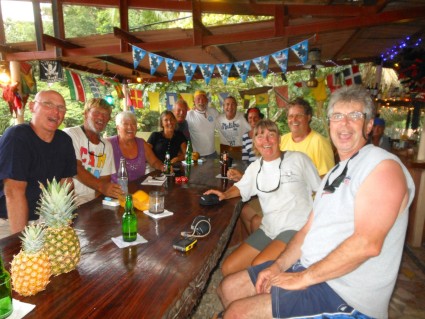
(This picture is a group of cruisers enjoying the fun and hospitality of Captain Jack's Bar and Hostel in Portobelo, Panama)
CUSTOMS AND IMMIGRATION FEES
We came to Panama for two reasons: we wanted to cruise the San Blas Islands; and we wanted to transit the Panama Canal and sail to the South Pacific. Additionally, we had guests coming from the US to cruise aboard TIGER LILLY and help us as line-handlers during our Panama Canal transit. There was plenty of information available on using Bonded Agents to set up our Panama Canal transit, and basing the boat at the Shelter Island Marina while making the necessary arrangements. For their convenience, all of the Bonded Canal Agents we contacted will only service yachts moored at the marina. We wanted to minimize our costs and avoid the $400-$500 Agent fee and $50/day marina charges. By all reports the Shelter Bay Marina is a POSH, full service facility; just the kind of place we don't usually patronize - our budget simply does not support the marina lifestyle. The marina is located across the bay from Colon, smack dab in the middle of nowhere, requiring long bus or taxi trips to go shopping. Typically, it takes about 4 days to make the Canal arrangements and load out the boat; so we are talking about saving almost $700 if we could figure out how to set up the Canal transit ourselves and avoid the marina. The reports coming from cruisers having recently cleared-in through Panamanian Customs & Immigration had quite a wide range of charges depending on where they cleared-in. Some boats were charged $110 per person for a visa and $96 for a Cruising Permit, and others were charged nothing. For a mom and pop cruising boat that comes to about $300, and added to the $700 costs associated with using Bonded Agents for the Canal amounts to $1000 - not an inconsiderable sum considering what you get - nothing, by our way of thinking. When it comes to Customs and Immigration procedures, when possible, we try to do the right thing. Following the rules of the countries we visit is an important part of leaving a clean wake for other cruisers who follow. However, sometimes, the bureaucratic system is so convoluted, or corrupt, that it simply is not practical or fair to follow all the regulations. A fundamental principal of the rule of law is that the laws be consistently enforced; and when they are not, in effect there are no rules. The Republic of Panama in 2014 is such a place.
PANAMA CANAL AUTHORITY (ACP)
The good news about Panama is that the Panama Canal Authority - separate from their political system - is a well run, efficient, professional organization which delivers good value for the money they charge. Tom had previously made the four passages through the Canal on both ships and yachts, and was able to make comparisons over a period of some 35 years. The Panama Canal Authority is dong a good job; they provide the Panamanian government with significant revenues, and offer substantial career opportunities for the Panamanian people. The Canal Authority has been so successful that they are well along in a significant up-grading and expansion of the locks.
PORTOBEL
Faced with the Panamanian Customs and Immigration situation, we had two choices - stay away from Panama, or go and make the best of it. We chose the latter - we wanted to sail to the South Pacific, and we were not ready to make the 7000 mile passage to Cape Horn to get there. We had heard through the jungle telegraph that there was a very accommodating Port Captain in Portobelo; and Portobelo has many advantages for a cruising yacht. One of the Caribbean's best natural harbours, Portobelo is located at a convenient place on Panama's North Coast; the breakwater entrance at Colon is an easy day sail (18 mile beam reach on the starboard tack), and the Cayos Holandes in the San Blas are reached by a delightful over-night passage (60 mile beam reach on the port tack). Portobelo is a charming little village with adequate local shopping, and easy bus access to Colon supermarkets and mall shopping. It is a safe place, and we felt comfortable walking back to the dinghy dock in the dark. On the other hand, Colon's security problems are many-fold and well documented. If we were not going to use a Bonded Agent for our Canal transit we would have to go there, but we wanted to complete our business with the Panama Canal Authority in Colon, and then leave as soon as possible.
COLUMBIA
While we were in Cartagena the captain of a back-packer boat which runs between Columbia and Panama told us about a fellow named Tito who helped folks arrange for their Canal transit, would operate out of Portobelo, and who had very reasonable rates. It was suggested that we go to Captain Jack's Bar and Hostel in Portobello and ask Jack to put us in contact with Tito. Based on this information, we decided that tentatively, Portobelo would be our base of operations in Panama, and hopefully, Tito would be our guy - that was our Panama Plan. After spending a delightful month in beautiful Cartagena we stopped in Columbia's Rosario Islands to clean TIGER LILLY's bottom. The growth that takes place on the UW hull of vessels anchored at Cartagena is absolutely amazing - and the harbour is not an inviting place to swim for bottom cleaning. Tom got in the water briefly to clean the propeller and the depth transducer; which is all we needed for the 24 mile motor-sail out to Los Rosarios in windless conditions. We anchored in 20 feet between Isla Grande and Isla Naval at 10 10.7N 07N 075 44.9W - the approach gets a little shallow, but we worked our 7 foot draft into this deep well-sheltered anchorage. There is an outer anchorage where you can wait for the tide (about one foot) if you need it. After our bottom cleaning project was completed, the passage to Portobelo, Panama from Los Rosarios, Columbia was a pleasant two day beam reach.
PORTOBELO PORT CAPTAIN
After our arrival at Portobelo we called at the Port Captain's office (marked "Immigration") multiple times in the first two days we were there before we found anyone in the office, this gave us a chance to contact Tito through Captain Jack before we talked with the Port Captain. Portobelo is a sleepy little village, and even the officials here are friendly and low-key. A pleasant lady who spoke no English stamped our passports, and Rolando the Port Captain, who did speak English, completed the remainder of the check-in process. Rolando was helpful and friendly, and neither he nor the Immigration lady said anything about going to Colon to get visas or cruising permits, nor did they ask for money. We told Rolando that Tito was handling our Canal transit (more on Tito to follow), and that we wanted to: 1) Sail to Colon to get admeasured and set up our Canal transit; 2) Return to Portobelo, load out provisions, and sail for the San Blas; 3) Cruise the San Blas Islands for a couple of weeks; 4) Return to Portobello, provision, and clear-out directly for French Polynesia; 5) Transit the Panama Canal; 6) Sail for the South Pacific. Rolando told us that we did not need a coastal zarpe to sail to Colon, but that he would issue us one for cruising the San Blas, and that we could in fact clear for French Polynesia at Portobelo just prior to our Canal transit; zarpes cost $20 each, and that seemed quite reasonable to us. It looked as though our Panama Plan was doable.
CAPTAIN JACK'S
While we were waiting for Rolando to show up at the Port Captain's office we walked up the hill and found Captain Jack's Bar and Hostel. Jack is the kind of guy who could easily be the subject of one of Jimmy Buffett's Caribbean ballads - and he became our Go-To Guy on Panama's North Coast. A highly successful and well-educated businessman from New Jersey, Jack went south, went native, and grew a pony tail. His Bar and Hostel is a first class establishment, and the social and information center for cruisers calling at Portobelo. It is located on a hill overlooking the bay, and the cool night air that comes down off the mountain is refreshing after the day's tropical heat.
TITO
When we asked Jack about Tito, he said that Tito was a good guy who had helped several boats with their Panama Canal transits; but that we should remember that this was Panama, and to expect "some surprises." Jack called Tito for us and we set up a meeting the following day at Jack's place. The first thing that Tito told us was that he was NOT an official bonded / registered agent of the Panama Canal, but that he could help us make our own Canal transit arrangements. We are DIY cruisers, and that sounded good to us. Tito was very familiar with the Customs and Immigration situation in Panama, and he told us that there was very little official presence on the north coast, and that Port Captain Rolando was a good guy whom he knew and had worked with in the past. He also said that we could stop at the Balboa Yacht Club on the Pacific side to take on fuel before departing - no one would ask, or care, if we were already checked-out. It sounded like (and later appeared to be the case) that Tito and Rolando had some sort of special arrangement. Tito explained that for his $75 fee he would make an appointment for us to be admeasured at the Yacht Flats (anchorage Foxtrot in Cristobal Harbor), transport us to the bank in Colon to get the necessary cash to pay our Canal fees, transport us to the accounting office to pay our Canal fees, deliver any transit gear or line-handlers we needed (on a carte blanch basis) to either Portobelo or the Yacht Flats at Cristobal, and pick-up any gear we rented on the Pacific side. Tito's 2014 charges are as follows: old tires wrapped in new plastic to be used as fenders - $3 each (we needed a total of 10, with 5 on each side); 125 ft mooring lines - $15 each (we had anchor rode which would meet the requirements, but we think it is better to rent lines since the lock walls are very rough concrete and rough on mooring lines - we needed four); and line-handlers - $20 each (the yacht provides them messing and berthing during the overnight transit - we did not need line-handlers).
PORTOBELO LOGISTICS
Our total bill for Tito's services and gear was $165, of which we paid $100 in advance with the balance due when he transported us to the bank and Canal Authority offices in Colon. Tito's telephone number is 6463-5009 (cell phones in Panama have 8 digits, and land line phones have 7 digits), and his email address is titoservicechildren@hotmail.com. We went to the Chinese grocery store in Portobello (past the cathedral, and across the street) and bought an el-cheapo Panamanian cell phone for $28, and a $10 pre-paid phone card so that we could be in touch with Tito and the Canal Authority offices - it was a really good investment, and made everything much easier. Jack's bartender Jeff was very helpful in assisting us in setting up our telephone, and also our iPad on the local 3G system - which at $30 per month was quite reasonably priced. The rub comes when trying to initiate these systems for the first time. It is a VERY convoluted procedure, explained in technical Spanish, and Jeff said that it is not at all unusual to watch visiting cruisers sit down at Captain Jack's and use up half the data plan or phone minutes getting set up. Thank you Jeff!
CUSTOMS AND IMMIGRATION ENFORCEMENT
Here is some practical information Tito gave us regarding Panamanian Immigration and Customs enforcement - which proved to be quite accurate: There is very little official presence on the waters of the North Coast, and there is no consistency in the fees charged at the various Panamanian offices ashore. There is a Panamanian Customs and Immigration office at the west end of the San Blas Islands at Isla Porvenir, but Tito told us to stay well off the coast as we sailed east for the Holandes. (We were already cleared into Panama, and the Porvenir Panamanian Customs and Immigration office has a reputation for collecting as much money as they can. We saw no need to go there.) The San Blas islands are semi-autonomous, and the Kuna Yala indian folks charge $30 for a cruising permit, and typically $5 to land on individual islands. The local Kuna official will come to your boat, collect the fee, and give you a receipt that will be honored at the other Kuna islands. (We thought that was a quite reasonable charge considering what a gorgeous place the San Blas Islands are to cruise.) Due to the upcoming South Pacific Cyclone Season, our timing was such that we only had two weeks to cruise the San Blas Islands. We very much enjoyed Cayos Holandes and Cayos Cocos Banderos - as did our guests. After our Canal transit we wanted to stop in Balboa to take on fuel, and provision at the Panama City supermarkets - large stores with plenty of choices and the best prices. Tito said "no problem" that no one would ask to see our papers on the Pacific side, and he was right. We wanted to stage the boat in Las Perlas before our long passage to French Polynesia, and Tito said that there was no official presence in the Las Perlas checking clearance papers. On Tito's recommendation, when Rolando issued our zarpe for French Polynesia, our passports were not stamped out - and that was a good thing. On the Pacific side we knew that we would be going ashore shopping, and although the boat was checked-out, the crew had passports showing that they were still legally in the country. If there was a problem while we were ashore (such as an injury or an accident), as individuals we were quite legal.
PANAMA CANAL ARRANGEMENTS
It all worked out as planned. We cleared-in at Portobello. Sailed down to Cristobal and were admeasured in the Yacht Flats. We motored four miles from Cristobol to Colon and anchored off Club Nautico (9-21.8N 079-53.6W). Tito picked us up and took us to a secure ATM where we made a $500 cash withdraw, then to the bank to make a credit card cash advance for the balance of our Canal fees, then to the Panama Canal Authority financial office to pay our fees - cash only in US greenbacks, thank you very much. The Canal fees were as follows: $800 transit toll (all vessels under 50 feet), $54 inspection / admeasurement charge, $130 security charge, $891 buffer (refundable deposit). We paid $1875 (in cash), and within 3 weeks of the completion of our transit had the $891 buffer returned electronically to our savings account. We think that we received good value for the $984 we paid to transit the Panama Canal. There is a good grocery store and a Laundromat within a one-half mile walk (turn left when coming out of the Club Nautico gate) - but remember, Colon is dangerous and we recommend a daylight only excursion for most Mom and Pop crews. By 1800 that same day we had a confirmed transit date - which was important to us as we had visitors coming, and they had to catch scheduled return flights after our Canal transit. Rather than stay at Colon overnight, for a more secure anchorage we motored just over a mile out to the northeast corner of the breakwater and anchored southwest of Punta Margarita (9-23.0N 079-53.6W). The next morning we sailed back to Portobelo, and took on provisions. We jerry-jugged good potable water from the community pier; see Manrekie at the dock - the fee is $20 for all the water you need. Port Captain Rolando issued us a coastal zarpe for $20, and we made an enjoyable night passage to the San Blas Islands. We cruised the San Blas for two weeks, returned to Portobelo, provisioned, picked-up our Zarpe for French Polynesia, and sailed for Cristobal and the Panama Canal.
PANAMA CANAL TRANSIT
Yachts transiting the Panama Canal from the Caribbean to the Pacific typically are scheduled for a two day transit which starts in the late afternoon. On the first day of our transit we picked-up our pilot at 1600 in the Flats (actually they are called Advisors for yachts - but make no mistake, they are in command when aboard), transited the Gatun Locks, and moored to a large buoy just over a mile to the east of the Gatun Locks in Lake Gatun. The next day we motored across Lake Gatun, locked down through the Pedro Miguel and Miraflores lock complex, and completed our transit. It was dark by the time we dropped off our pilot in the Balboa Reach on the Pacific side. The Panama Canal is one of the Man-Made Wonders of the World, and our Canal transit was a most interesting and enjoyable experience - thanks to a lot of planning and preparation on our part, and really sharp, professional, friendly Canal Authority pilots.
LINE-HANDLERS
Each yacht transiting the Panama Canal is required to have four line-handlers aboard, in addition to the skipper. This requirement should not be taken lightly. The turbulence in the locks and the strain on the mooring lines, particularly when locking down, is formidable; line-handlers need to be physically strong, and they need to know how to work a line on a cleat when it is under heavy strain. Landsmen brought aboard as guests need instruction and close supervision if personal injury and damage to the vessel are to be avoided. The skipper is often busy maneuvering the boat and working with the pilot, and is unable to give the line-handlers the close supervision required during the most critical time. We were fortunate in that we had another cruising yacht skipper aboard TIGER LILLY and he acted as our deck supervisor during locking operations. It has been our experience, during multiple transits of the Canal, that the pilots are very capable, professional, and friendly; they gave a very thorough brief to the line-handlers and the skipper before each locking operation. We locked through made-up to another yacht, so usually we were only working two lines instead of four, but we had to be equipped and ready to work all four of our mooring lines simultaneously should the other yacht have a casualty. Most of the problems encountered by yachts during their transit can be attributed to improper handling of the mooring lines. A word to the wise should be sufficient: good line-handling is critical for a safe and enjoyable transit of the Panama Canal.
TRANSIT GEAR
In the aggregate, we were very satisfied with Tito and his services. The only problem was with the tires (fenders) which his son was supposed to arrange. When the tires arrived by launch at the Flats there were only eight instead of the ten we arranged, none of them had attachment lines, and two of the tries had jagged steel reinforcement belts protruding out the side. Apparently, attention to detail was not one of the lad's personal qualities. A quick call to Tito sorted it out, and within the hour we had the right number of good tires with attachment lines. We were glad that we had arrived early at the Flats so that this problem did not affect our Canal transit. The other problem was at the finish of our Canal transit at the Balboa Yacht Club where another one of Tito's relatives was supposed to pick-up the tires, but never showed up (probably because we were delayed in the Canal and we exited the last lock about two hours later than was scheduled). The Yacht Club Dock Master wanted a $2 disposal fee for each tire, so we gave him Tito's 4 mooring lines and told him to hold the lines hostage until Tito, or his designated representative, showed up for the tires. We called Tito and told him what we did, and he was quite apologetic for the situation. We remember that Captain Jack in Portobello had reminded us that "This was Panama, and be ready for some surprises!" Tito and his wife operate a Christian orphanage, and his yacht services business is an augment to their income. Tito is a Chinese-Panamanian, speaks understandable English, he seems to be well-connected, and as we went around to the various offices in Colon he was very well received. Tito is a good guy, and we are more than satisfied with his services.
GUESTS ABOARD
Panama is a great place to have family and friends aboard. The San Blas Islands are a world-class cruising destination, and the Panama Canal transit is a once-in-a-lifetime experience for most landsmen. Panama's international airport is on the Pacific side at Panama City, and guests need to cross the isthmus and meet their yacht on the Caribbean side. Here are the arrangements we made. Tom's brother flew in from Tampa to the Panama airport, took a $75 taxi to Colon (should have been a $50 charge), and met us at Club Nautico on the afternoon of our admeasurement. Our friend from Jacksonville flew in to Panama, spent the night at Mamallena's Hostel in Panama City ($13 per night, details on Google) took a 4WD taxi (Mamallena's will set it up for you) across the mountains to Puerto Carti in the San Blas ($50, details on their website on Google), and then a $5 local water taxi delivered him to TIGER LILLY waiting off the Carti Islands of San Blas. Alternatively (and much cheaper) one could take a bus from the airport to the Panama City Bus Station at the Albrook Mall, board another bus to the Colon Bus Station, and catch a bus to Portobello. This bus daisy-chain should only be attempted during the hours of daylight; since most international flights arrive in Panama City in the early afternoon, prudence would dictate an overnight stay at Mamallena's Hostel with an early morning departure from Panama City. Should the yacht not be able to keep her schedule and meet the guests at Portobelo, the hostel side of Captain Jack's fine establishment is a safe, clean, economical, and enjoyable place for them to stay until you can come and collect them. Of course, there are many more ways to skin this cat, but this is how we got our guests safely to us in Panama.
PACIFIC SIDE
Once our pilot disembarked at Balboa we proceeded to the Balboa Yacht Club ($30 per night for a mooring buoy). We had to moor in the dark, but the club launch responded to our VHF radio call, came out and met us in the channel, escorted us through the mooring field, and helped us pick-up the mooring buoy - all much appreciated after a very long day. Diesel fuel at the Balboa Yacht club cost $4.06 per US gallon, but we recommend that you check on the VHF that they actually have fuel before going along side their very rough steel dock. There are some pretty heavy wakes in the area from crew boats servicing the commercial anchorage, so fender-up well before going alongside. After fueling, off-loading our transit gear, and putting our guests in a taxi for the airport, we moved out to the La Playita anchorage (8-54.6N 079-31.5W), got on our own anchor, and enjoyed PACIFICA! Unfortunately, the marina at La Playita charges $32 per week to use their dinghy dock, and there are no daily rates. With the 14-16 foot tides and stores to load, we needed their dinghy dock, so we paid the fee. They do sell diesel fuel at La Playita, but this is a power boat marina, they don't seem to appreciate the cruising sailor's business, and we recommend that you buy fuel at the Balboa Yacht Club - which has been taking very good care of sailors for years. The bus comes right out to the marina at La Playita, and Panama City has an excellent bus system; the bus station is at a large mall in a safe area with a very good grocery store. After departing the mainland we called at Isla Taboga on the way out to the Las Perlas. In the Las Perlas we anchored at a beautiful anchorage at Isla Pedro Gonzales (8-41.1N 079-04.9W), and off the village of Esmeralda on the southeast corner of Isla Del Rey. La Esmeralda had little to offer, and we recommend giving it a pass. After hoisting the dinghy and securing for sea, we were off on a 4100 mile passage to Iles Gambier in French Polynesia - we were excited to be heading for the South Seas!
CUSTOMS AND IMMIGRATION FEES
We came to Panama for two reasons: we wanted to cruise the San Blas Islands; and we wanted to transit the Panama Canal and sail to the South Pacific. Additionally, we had guests coming from the US to cruise aboard TIGER LILLY and help us as line-handlers during our Panama Canal transit. There was plenty of information available on using Bonded Agents to set up our Panama Canal transit, and basing the boat at the Shelter Island Marina while making the necessary arrangements. For their convenience, all of the Bonded Canal Agents we contacted will only service yachts moored at the marina. We wanted to minimize our costs and avoid the $400-$500 Agent fee and $50/day marina charges. By all reports the Shelter Bay Marina is a POSH, full service facility; just the kind of place we don't usually patronize - our budget simply does not support the marina lifestyle. The marina is located across the bay from Colon, smack dab in the middle of nowhere, requiring long bus or taxi trips to go shopping. Typically, it takes about 4 days to make the Canal arrangements and load out the boat; so we are talking about saving almost $700 if we could figure out how to set up the Canal transit ourselves and avoid the marina. The reports coming from cruisers having recently cleared-in through Panamanian Customs & Immigration had quite a wide range of charges depending on where they cleared-in. Some boats were charged $110 per person for a visa and $96 for a Cruising Permit, and others were charged nothing. For a mom and pop cruising boat that comes to about $300, and added to the $700 costs associated with using Bonded Agents for the Canal amounts to $1000 - not an inconsiderable sum considering what you get - nothing, by our way of thinking. When it comes to Customs and Immigration procedures, when possible, we try to do the right thing. Following the rules of the countries we visit is an important part of leaving a clean wake for other cruisers who follow. However, sometimes, the bureaucratic system is so convoluted, or corrupt, that it simply is not practical or fair to follow all the regulations. A fundamental principal of the rule of law is that the laws be consistently enforced; and when they are not, in effect there are no rules. The Republic of Panama in 2014 is such a place.
PANAMA CANAL AUTHORITY (ACP)
The good news about Panama is that the Panama Canal Authority - separate from their political system - is a well run, efficient, professional organization which delivers good value for the money they charge. Tom had previously made the four passages through the Canal on both ships and yachts, and was able to make comparisons over a period of some 35 years. The Panama Canal Authority is dong a good job; they provide the Panamanian government with significant revenues, and offer substantial career opportunities for the Panamanian people. The Canal Authority has been so successful that they are well along in a significant up-grading and expansion of the locks.
PORTOBEL
Faced with the Panamanian Customs and Immigration situation, we had two choices - stay away from Panama, or go and make the best of it. We chose the latter - we wanted to sail to the South Pacific, and we were not ready to make the 7000 mile passage to Cape Horn to get there. We had heard through the jungle telegraph that there was a very accommodating Port Captain in Portobelo; and Portobelo has many advantages for a cruising yacht. One of the Caribbean's best natural harbours, Portobelo is located at a convenient place on Panama's North Coast; the breakwater entrance at Colon is an easy day sail (18 mile beam reach on the starboard tack), and the Cayos Holandes in the San Blas are reached by a delightful over-night passage (60 mile beam reach on the port tack). Portobelo is a charming little village with adequate local shopping, and easy bus access to Colon supermarkets and mall shopping. It is a safe place, and we felt comfortable walking back to the dinghy dock in the dark. On the other hand, Colon's security problems are many-fold and well documented. If we were not going to use a Bonded Agent for our Canal transit we would have to go there, but we wanted to complete our business with the Panama Canal Authority in Colon, and then leave as soon as possible.
COLUMBIA
While we were in Cartagena the captain of a back-packer boat which runs between Columbia and Panama told us about a fellow named Tito who helped folks arrange for their Canal transit, would operate out of Portobelo, and who had very reasonable rates. It was suggested that we go to Captain Jack's Bar and Hostel in Portobello and ask Jack to put us in contact with Tito. Based on this information, we decided that tentatively, Portobelo would be our base of operations in Panama, and hopefully, Tito would be our guy - that was our Panama Plan. After spending a delightful month in beautiful Cartagena we stopped in Columbia's Rosario Islands to clean TIGER LILLY's bottom. The growth that takes place on the UW hull of vessels anchored at Cartagena is absolutely amazing - and the harbour is not an inviting place to swim for bottom cleaning. Tom got in the water briefly to clean the propeller and the depth transducer; which is all we needed for the 24 mile motor-sail out to Los Rosarios in windless conditions. We anchored in 20 feet between Isla Grande and Isla Naval at 10 10.7N 07N 075 44.9W - the approach gets a little shallow, but we worked our 7 foot draft into this deep well-sheltered anchorage. There is an outer anchorage where you can wait for the tide (about one foot) if you need it. After our bottom cleaning project was completed, the passage to Portobelo, Panama from Los Rosarios, Columbia was a pleasant two day beam reach.
PORTOBELO PORT CAPTAIN
After our arrival at Portobelo we called at the Port Captain's office (marked "Immigration") multiple times in the first two days we were there before we found anyone in the office, this gave us a chance to contact Tito through Captain Jack before we talked with the Port Captain. Portobelo is a sleepy little village, and even the officials here are friendly and low-key. A pleasant lady who spoke no English stamped our passports, and Rolando the Port Captain, who did speak English, completed the remainder of the check-in process. Rolando was helpful and friendly, and neither he nor the Immigration lady said anything about going to Colon to get visas or cruising permits, nor did they ask for money. We told Rolando that Tito was handling our Canal transit (more on Tito to follow), and that we wanted to: 1) Sail to Colon to get admeasured and set up our Canal transit; 2) Return to Portobelo, load out provisions, and sail for the San Blas; 3) Cruise the San Blas Islands for a couple of weeks; 4) Return to Portobello, provision, and clear-out directly for French Polynesia; 5) Transit the Panama Canal; 6) Sail for the South Pacific. Rolando told us that we did not need a coastal zarpe to sail to Colon, but that he would issue us one for cruising the San Blas, and that we could in fact clear for French Polynesia at Portobelo just prior to our Canal transit; zarpes cost $20 each, and that seemed quite reasonable to us. It looked as though our Panama Plan was doable.
CAPTAIN JACK'S
While we were waiting for Rolando to show up at the Port Captain's office we walked up the hill and found Captain Jack's Bar and Hostel. Jack is the kind of guy who could easily be the subject of one of Jimmy Buffett's Caribbean ballads - and he became our Go-To Guy on Panama's North Coast. A highly successful and well-educated businessman from New Jersey, Jack went south, went native, and grew a pony tail. His Bar and Hostel is a first class establishment, and the social and information center for cruisers calling at Portobelo. It is located on a hill overlooking the bay, and the cool night air that comes down off the mountain is refreshing after the day's tropical heat.
TITO
When we asked Jack about Tito, he said that Tito was a good guy who had helped several boats with their Panama Canal transits; but that we should remember that this was Panama, and to expect "some surprises." Jack called Tito for us and we set up a meeting the following day at Jack's place. The first thing that Tito told us was that he was NOT an official bonded / registered agent of the Panama Canal, but that he could help us make our own Canal transit arrangements. We are DIY cruisers, and that sounded good to us. Tito was very familiar with the Customs and Immigration situation in Panama, and he told us that there was very little official presence on the north coast, and that Port Captain Rolando was a good guy whom he knew and had worked with in the past. He also said that we could stop at the Balboa Yacht Club on the Pacific side to take on fuel before departing - no one would ask, or care, if we were already checked-out. It sounded like (and later appeared to be the case) that Tito and Rolando had some sort of special arrangement. Tito explained that for his $75 fee he would make an appointment for us to be admeasured at the Yacht Flats (anchorage Foxtrot in Cristobal Harbor), transport us to the bank in Colon to get the necessary cash to pay our Canal fees, transport us to the accounting office to pay our Canal fees, deliver any transit gear or line-handlers we needed (on a carte blanch basis) to either Portobelo or the Yacht Flats at Cristobal, and pick-up any gear we rented on the Pacific side. Tito's 2014 charges are as follows: old tires wrapped in new plastic to be used as fenders - $3 each (we needed a total of 10, with 5 on each side); 125 ft mooring lines - $15 each (we had anchor rode which would meet the requirements, but we think it is better to rent lines since the lock walls are very rough concrete and rough on mooring lines - we needed four); and line-handlers - $20 each (the yacht provides them messing and berthing during the overnight transit - we did not need line-handlers).
PORTOBELO LOGISTICS
Our total bill for Tito's services and gear was $165, of which we paid $100 in advance with the balance due when he transported us to the bank and Canal Authority offices in Colon. Tito's telephone number is 6463-5009 (cell phones in Panama have 8 digits, and land line phones have 7 digits), and his email address is titoservicechildren@hotmail.com. We went to the Chinese grocery store in Portobello (past the cathedral, and across the street) and bought an el-cheapo Panamanian cell phone for $28, and a $10 pre-paid phone card so that we could be in touch with Tito and the Canal Authority offices - it was a really good investment, and made everything much easier. Jack's bartender Jeff was very helpful in assisting us in setting up our telephone, and also our iPad on the local 3G system - which at $30 per month was quite reasonably priced. The rub comes when trying to initiate these systems for the first time. It is a VERY convoluted procedure, explained in technical Spanish, and Jeff said that it is not at all unusual to watch visiting cruisers sit down at Captain Jack's and use up half the data plan or phone minutes getting set up. Thank you Jeff!
CUSTOMS AND IMMIGRATION ENFORCEMENT
Here is some practical information Tito gave us regarding Panamanian Immigration and Customs enforcement - which proved to be quite accurate: There is very little official presence on the waters of the North Coast, and there is no consistency in the fees charged at the various Panamanian offices ashore. There is a Panamanian Customs and Immigration office at the west end of the San Blas Islands at Isla Porvenir, but Tito told us to stay well off the coast as we sailed east for the Holandes. (We were already cleared into Panama, and the Porvenir Panamanian Customs and Immigration office has a reputation for collecting as much money as they can. We saw no need to go there.) The San Blas islands are semi-autonomous, and the Kuna Yala indian folks charge $30 for a cruising permit, and typically $5 to land on individual islands. The local Kuna official will come to your boat, collect the fee, and give you a receipt that will be honored at the other Kuna islands. (We thought that was a quite reasonable charge considering what a gorgeous place the San Blas Islands are to cruise.) Due to the upcoming South Pacific Cyclone Season, our timing was such that we only had two weeks to cruise the San Blas Islands. We very much enjoyed Cayos Holandes and Cayos Cocos Banderos - as did our guests. After our Canal transit we wanted to stop in Balboa to take on fuel, and provision at the Panama City supermarkets - large stores with plenty of choices and the best prices. Tito said "no problem" that no one would ask to see our papers on the Pacific side, and he was right. We wanted to stage the boat in Las Perlas before our long passage to French Polynesia, and Tito said that there was no official presence in the Las Perlas checking clearance papers. On Tito's recommendation, when Rolando issued our zarpe for French Polynesia, our passports were not stamped out - and that was a good thing. On the Pacific side we knew that we would be going ashore shopping, and although the boat was checked-out, the crew had passports showing that they were still legally in the country. If there was a problem while we were ashore (such as an injury or an accident), as individuals we were quite legal.
PANAMA CANAL ARRANGEMENTS
It all worked out as planned. We cleared-in at Portobello. Sailed down to Cristobal and were admeasured in the Yacht Flats. We motored four miles from Cristobol to Colon and anchored off Club Nautico (9-21.8N 079-53.6W). Tito picked us up and took us to a secure ATM where we made a $500 cash withdraw, then to the bank to make a credit card cash advance for the balance of our Canal fees, then to the Panama Canal Authority financial office to pay our fees - cash only in US greenbacks, thank you very much. The Canal fees were as follows: $800 transit toll (all vessels under 50 feet), $54 inspection / admeasurement charge, $130 security charge, $891 buffer (refundable deposit). We paid $1875 (in cash), and within 3 weeks of the completion of our transit had the $891 buffer returned electronically to our savings account. We think that we received good value for the $984 we paid to transit the Panama Canal. There is a good grocery store and a Laundromat within a one-half mile walk (turn left when coming out of the Club Nautico gate) - but remember, Colon is dangerous and we recommend a daylight only excursion for most Mom and Pop crews. By 1800 that same day we had a confirmed transit date - which was important to us as we had visitors coming, and they had to catch scheduled return flights after our Canal transit. Rather than stay at Colon overnight, for a more secure anchorage we motored just over a mile out to the northeast corner of the breakwater and anchored southwest of Punta Margarita (9-23.0N 079-53.6W). The next morning we sailed back to Portobelo, and took on provisions. We jerry-jugged good potable water from the community pier; see Manrekie at the dock - the fee is $20 for all the water you need. Port Captain Rolando issued us a coastal zarpe for $20, and we made an enjoyable night passage to the San Blas Islands. We cruised the San Blas for two weeks, returned to Portobelo, provisioned, picked-up our Zarpe for French Polynesia, and sailed for Cristobal and the Panama Canal.
PANAMA CANAL TRANSIT
Yachts transiting the Panama Canal from the Caribbean to the Pacific typically are scheduled for a two day transit which starts in the late afternoon. On the first day of our transit we picked-up our pilot at 1600 in the Flats (actually they are called Advisors for yachts - but make no mistake, they are in command when aboard), transited the Gatun Locks, and moored to a large buoy just over a mile to the east of the Gatun Locks in Lake Gatun. The next day we motored across Lake Gatun, locked down through the Pedro Miguel and Miraflores lock complex, and completed our transit. It was dark by the time we dropped off our pilot in the Balboa Reach on the Pacific side. The Panama Canal is one of the Man-Made Wonders of the World, and our Canal transit was a most interesting and enjoyable experience - thanks to a lot of planning and preparation on our part, and really sharp, professional, friendly Canal Authority pilots.
LINE-HANDLERS
Each yacht transiting the Panama Canal is required to have four line-handlers aboard, in addition to the skipper. This requirement should not be taken lightly. The turbulence in the locks and the strain on the mooring lines, particularly when locking down, is formidable; line-handlers need to be physically strong, and they need to know how to work a line on a cleat when it is under heavy strain. Landsmen brought aboard as guests need instruction and close supervision if personal injury and damage to the vessel are to be avoided. The skipper is often busy maneuvering the boat and working with the pilot, and is unable to give the line-handlers the close supervision required during the most critical time. We were fortunate in that we had another cruising yacht skipper aboard TIGER LILLY and he acted as our deck supervisor during locking operations. It has been our experience, during multiple transits of the Canal, that the pilots are very capable, professional, and friendly; they gave a very thorough brief to the line-handlers and the skipper before each locking operation. We locked through made-up to another yacht, so usually we were only working two lines instead of four, but we had to be equipped and ready to work all four of our mooring lines simultaneously should the other yacht have a casualty. Most of the problems encountered by yachts during their transit can be attributed to improper handling of the mooring lines. A word to the wise should be sufficient: good line-handling is critical for a safe and enjoyable transit of the Panama Canal.
TRANSIT GEAR
In the aggregate, we were very satisfied with Tito and his services. The only problem was with the tires (fenders) which his son was supposed to arrange. When the tires arrived by launch at the Flats there were only eight instead of the ten we arranged, none of them had attachment lines, and two of the tries had jagged steel reinforcement belts protruding out the side. Apparently, attention to detail was not one of the lad's personal qualities. A quick call to Tito sorted it out, and within the hour we had the right number of good tires with attachment lines. We were glad that we had arrived early at the Flats so that this problem did not affect our Canal transit. The other problem was at the finish of our Canal transit at the Balboa Yacht Club where another one of Tito's relatives was supposed to pick-up the tires, but never showed up (probably because we were delayed in the Canal and we exited the last lock about two hours later than was scheduled). The Yacht Club Dock Master wanted a $2 disposal fee for each tire, so we gave him Tito's 4 mooring lines and told him to hold the lines hostage until Tito, or his designated representative, showed up for the tires. We called Tito and told him what we did, and he was quite apologetic for the situation. We remember that Captain Jack in Portobello had reminded us that "This was Panama, and be ready for some surprises!" Tito and his wife operate a Christian orphanage, and his yacht services business is an augment to their income. Tito is a Chinese-Panamanian, speaks understandable English, he seems to be well-connected, and as we went around to the various offices in Colon he was very well received. Tito is a good guy, and we are more than satisfied with his services.
GUESTS ABOARD
Panama is a great place to have family and friends aboard. The San Blas Islands are a world-class cruising destination, and the Panama Canal transit is a once-in-a-lifetime experience for most landsmen. Panama's international airport is on the Pacific side at Panama City, and guests need to cross the isthmus and meet their yacht on the Caribbean side. Here are the arrangements we made. Tom's brother flew in from Tampa to the Panama airport, took a $75 taxi to Colon (should have been a $50 charge), and met us at Club Nautico on the afternoon of our admeasurement. Our friend from Jacksonville flew in to Panama, spent the night at Mamallena's Hostel in Panama City ($13 per night, details on Google) took a 4WD taxi (Mamallena's will set it up for you) across the mountains to Puerto Carti in the San Blas ($50, details on their website on Google), and then a $5 local water taxi delivered him to TIGER LILLY waiting off the Carti Islands of San Blas. Alternatively (and much cheaper) one could take a bus from the airport to the Panama City Bus Station at the Albrook Mall, board another bus to the Colon Bus Station, and catch a bus to Portobello. This bus daisy-chain should only be attempted during the hours of daylight; since most international flights arrive in Panama City in the early afternoon, prudence would dictate an overnight stay at Mamallena's Hostel with an early morning departure from Panama City. Should the yacht not be able to keep her schedule and meet the guests at Portobelo, the hostel side of Captain Jack's fine establishment is a safe, clean, economical, and enjoyable place for them to stay until you can come and collect them. Of course, there are many more ways to skin this cat, but this is how we got our guests safely to us in Panama.
PACIFIC SIDE
Once our pilot disembarked at Balboa we proceeded to the Balboa Yacht Club ($30 per night for a mooring buoy). We had to moor in the dark, but the club launch responded to our VHF radio call, came out and met us in the channel, escorted us through the mooring field, and helped us pick-up the mooring buoy - all much appreciated after a very long day. Diesel fuel at the Balboa Yacht club cost $4.06 per US gallon, but we recommend that you check on the VHF that they actually have fuel before going along side their very rough steel dock. There are some pretty heavy wakes in the area from crew boats servicing the commercial anchorage, so fender-up well before going alongside. After fueling, off-loading our transit gear, and putting our guests in a taxi for the airport, we moved out to the La Playita anchorage (8-54.6N 079-31.5W), got on our own anchor, and enjoyed PACIFICA! Unfortunately, the marina at La Playita charges $32 per week to use their dinghy dock, and there are no daily rates. With the 14-16 foot tides and stores to load, we needed their dinghy dock, so we paid the fee. They do sell diesel fuel at La Playita, but this is a power boat marina, they don't seem to appreciate the cruising sailor's business, and we recommend that you buy fuel at the Balboa Yacht Club - which has been taking very good care of sailors for years. The bus comes right out to the marina at La Playita, and Panama City has an excellent bus system; the bus station is at a large mall in a safe area with a very good grocery store. After departing the mainland we called at Isla Taboga on the way out to the Las Perlas. In the Las Perlas we anchored at a beautiful anchorage at Isla Pedro Gonzales (8-41.1N 079-04.9W), and off the village of Esmeralda on the southeast corner of Isla Del Rey. La Esmeralda had little to offer, and we recommend giving it a pass. After hoisting the dinghy and securing for sea, we were off on a 4100 mile passage to Iles Gambier in French Polynesia - we were excited to be heading for the South Seas!
Comments
| Vessel Name: | Tiger Lilly |
| Vessel Make/Model: | 1977 CSY44 walkover hull #55 |
| Hailing Port: | Green Cove Springs |
| Crew: | Lilly and Tom Service |
| About: | |
| Extra: | |
| Social: |
Tiger Lilly's Photos - Main
S/V Tiger Lilly
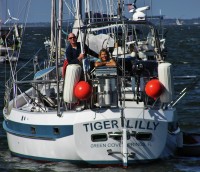
Who: Lilly and Tom Service
Port: Green Cove Springs

